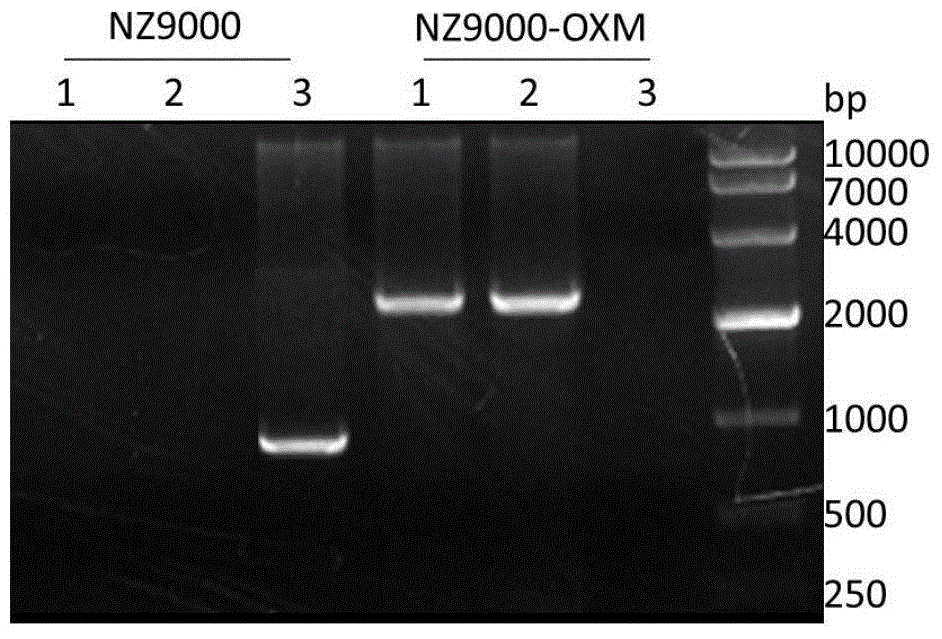Transformant for reducing weight and fat and construction method and application thereof
A transformant and lipid-lowering technology, applied in the field of biomedicine, can solve problems such as host drug resistance and host intestinal flora disorder, and achieve the effects of overcoming high production costs, convenient medication, and low cost
- Summary
- Abstract
- Description
- Claims
- Application Information
AI Technical Summary
Problems solved by technology
Method used
Image
Examples
Embodiment 1
[0040] Example 1: Preparation of Lactococcus lactis transformed with OXM gene.
[0041] (1) Construction of homologous recombination fragments:
[0042] According to the published thyA gene sequence in the whole genome of lactic acid bacteria L. lactis, the sequences of 1000 bp upstream of the start codon and 1000 bp downstream of the stop codon were respectively found.
[0043] According to the human OXM amino acid and nucleic acid sequence, referring to the codon usage frequency of Lactococcus lactis, the OXM nucleic acid sequence was optimized, and the obtained sequence is shown in SEQ ID NO:1.
[0044] Artificial chemically synthesized gene fragment OXM-M: Lactococcus lactis thyA gene start codon upstream 1000bp + human OXM gene sequence + Lactobacillus thyA stop codon downstream 1000bp sequence.
[0045] (2), preparation and screening of OXM transgenic Lactococcus lactis:
[0046] The human oxyntomodulin fragment OXM-M was electrotransformed into the strain L.lactis NZ9...
Embodiment 2
[0065] Example 2: Pharmacodynamic experiment of OXM-transformed lactic acid bacteria for weight loss and lipid-lowering.
[0066] (1) Several newly weaned B6 mice were prepared and fed with high fat until the obese mice were successfully established. The obesity standard is: (body weight of the experimental group-average body weight of normal mice) / average body weight of normal mice>20%. The obese mice were divided into two groups, 10 in each group, and continued to be fed with a high-fat diet. One group is the control group, fed with Lactococcus lactis L. lactis NZ9000. The other group is the experimental group, feeding Lactococcus lactis L. lactis NZ9000-OXM. At the same time, a normal control group was set up, that is, normal diet B6 mice were not fed Lactococcus lactis.
[0067] (2) Each mouse was given 5*10 by gavage 9 CFU Lactococcus lactis, orally administered once every 2 days. The body weight, food intake and other vital signs of the mice were tracked and observe...
Embodiment 3
[0072] Example 3: Pharmacodynamic experiment of OXM-transformed lactic acid bacteria on weight loss and lipid-lowering in gene-deficient diabetic mice.
[0073] 1. Prepare 20 db / db mice at the age of 8 weeks, and divide the obese mice into 2 groups, 10 in each group. One group is the control group, fed with Lactococcus lactis L. lactis NZ9000. The other group is the experimental group, fed with Lactococcus lactis L.lactisNZ9000-OXM. At the same time, a normal control group was set up, that is, normal diet B6 mice were not fed Lactococcus lactis.
[0074] 2. Each mouse was given 5*10 by gavage 9 CFU Lactococcus lactis, orally administered every day. Weight monitoring data such as Figure 11 As shown, the body weight of mice fed with OXM group can be maintained unchanged compared with their own body weight before administration. However, the body weight of the mice in the NZ9000 group continued to increase by about 8% in 5 weeks. Through this experiment, it can be found th...
PUM
 Login to View More
Login to View More Abstract
Description
Claims
Application Information
 Login to View More
Login to View More - R&D
- Intellectual Property
- Life Sciences
- Materials
- Tech Scout
- Unparalleled Data Quality
- Higher Quality Content
- 60% Fewer Hallucinations
Browse by: Latest US Patents, China's latest patents, Technical Efficacy Thesaurus, Application Domain, Technology Topic, Popular Technical Reports.
© 2025 PatSnap. All rights reserved.Legal|Privacy policy|Modern Slavery Act Transparency Statement|Sitemap|About US| Contact US: help@patsnap.com



